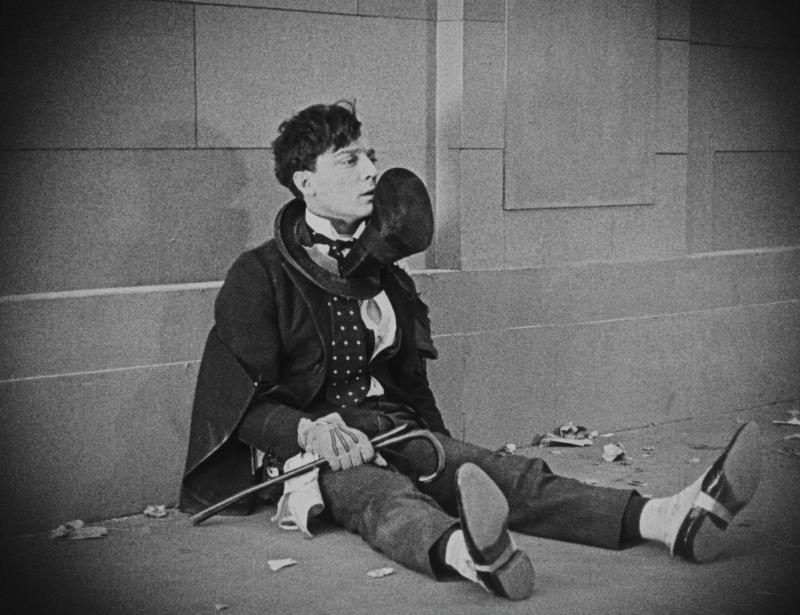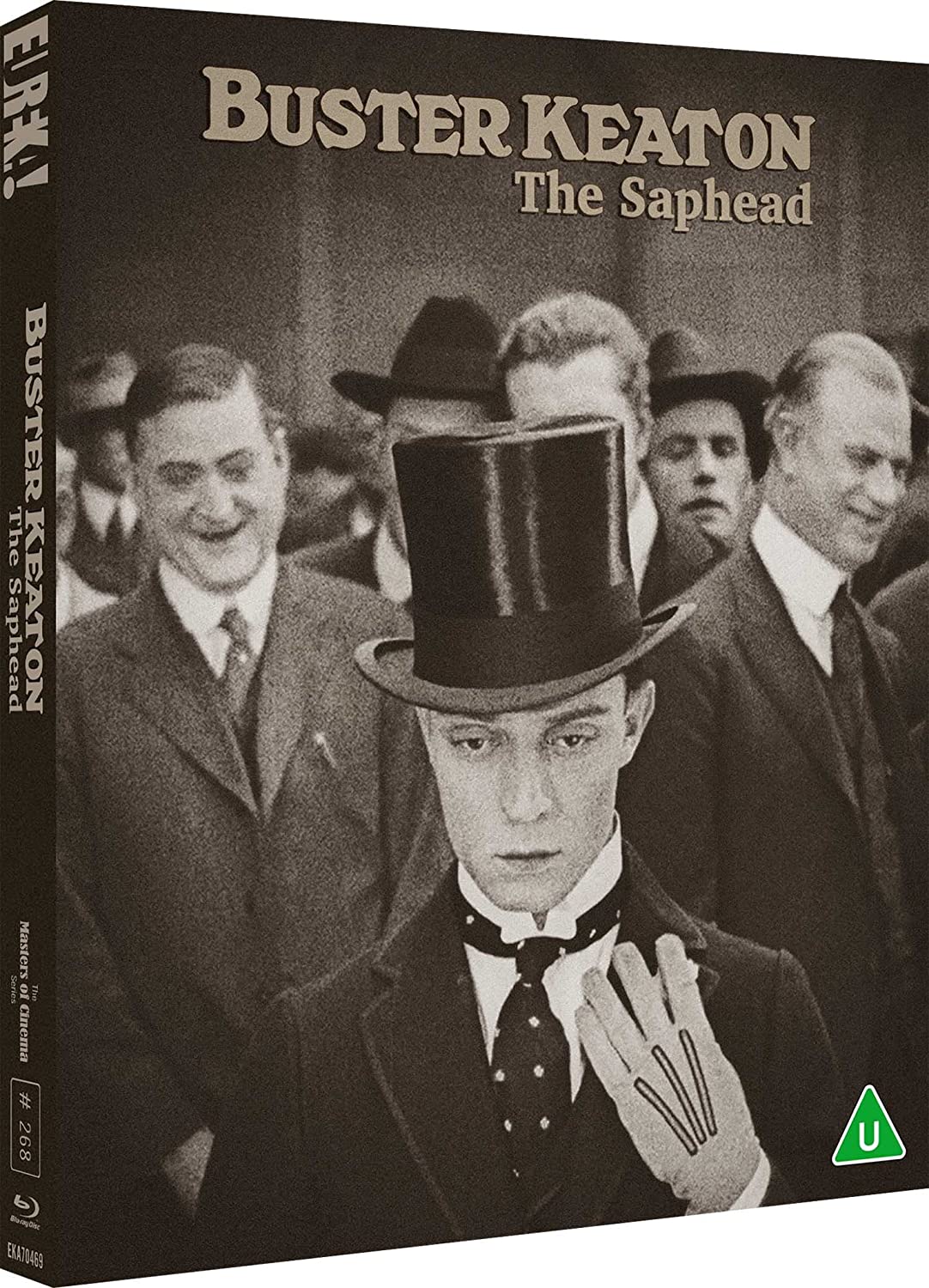Blu-ray: The Saphead | reviews, news & interviews
Blu-ray: The Saphead
Blu-ray: The Saphead
Buster Keaton's intermittently entertaining feature debut, with enticing extras

Buster Keaton made his name in a series of two-reel shorts made from 1917 onwards; The Saphead, from 1920, was his first starring role in a feature film.
It’s in no way comparable to the classics which Keaton produced and directed in his mid-1920s purple patch, the wordy screenplay cobbled together from a pair of popular stage plays and the film directed in workmanlike fashion by Herbert Blaché, who wasn’t familiar with Keaton. Douglas Fairbanks was originally slated to star, recommending his younger colleague for the part of Bertie Van Alstyne when he found himself unavailable.
 That Keaton had very little creative input soon becomes clear; for the most part, The Saphead is a stodgy, over-complicated farce which only becomes diverting when he’s on screen. Keaton’s Bertie is a foppish innocent, an indulged manchild who shows no interest in following his father Nicholas (William H Crane), “the richest man in New York”, to Wall Street. The plot centres on Bertie’s villainous brother-in-law Mark (Irving Cummings) and his efforts to cheat Nicholas out of the family fortune.
That Keaton had very little creative input soon becomes clear; for the most part, The Saphead is a stodgy, over-complicated farce which only becomes diverting when he’s on screen. Keaton’s Bertie is a foppish innocent, an indulged manchild who shows no interest in following his father Nicholas (William H Crane), “the richest man in New York”, to Wall Street. The plot centres on Bertie’s villainous brother-in-law Mark (Irving Cummings) and his efforts to cheat Nicholas out of the family fortune.
Keaton is as otherworldly as ever; we first see him picking at an afternoon breakfast like a pampered pet, waited upon by a pair of fawning servants. Bertie attempts to impress his adopted sister Agnes (Beulah Booker) by behaving like a sophisticated man about town, one sequence seeing him failing to get arrested after a night of illegal gambling. A marriage ceremony doesn’t go to plan, and Bertie eventually pitches up on the floor of the Stock Exchange, mocked and manhandled by other traders before inadvertently saving the family fortune. Despite the multiple locations, The Saphead feels stagey and claustrophobic, fun though it is to see ticker tape machines clattering away behind the cigar smoke in the office scenes.
Keaton’s self-directed films are remarkable for their lack of dialogue cards; they’re simply not needed, whereas reading through the text in The Saphead can be like wading through treacle. Worth seeing, then, but essentially one for completists. Still, it looks immaculate in this Masters of Cinema restoration, taken from a first-generation nitrate print. Andrew Earle Simpson’s occasionally spiky score is effective. Eureka’s generous bonus features make the set worth acquiring. They include a second version of the film comprised of different takes and camera angles, a comparative featurette explaining that studios often produced alternative cuts of film for international markets. Audio-only interviews with the elderly Keaton are fascinating, but the main draw is a chance to see the great man's final screen appearance in The Scribe, a 1966 Canadian short intended to teach construction workers about building site safety. Though he looks frail, Keaton’s comic chops are very much intact, the sight gags involving lifts, dropped bricks and feet getting stuck in buckets still funny.
rating
Share this article
The future of Arts Journalism
You can stop theartsdesk.com closing!
We urgently need financing to survive. Our fundraising drive has thus far raised £49,000 but we need to reach £100,000 or we will be forced to close. Please contribute here: https://gofund.me/c3f6033d
And if you can forward this information to anyone who might assist, we’d be grateful.

Subscribe to theartsdesk.com
Thank you for continuing to read our work on theartsdesk.com. For unlimited access to every article in its entirety, including our archive of more than 15,000 pieces, we're asking for £5 per month or £40 per year. We feel it's a very good deal, and hope you do too.
To take a subscription now simply click here.
And if you're looking for that extra gift for a friend or family member, why not treat them to a theartsdesk.com gift subscription?
more Film
 Blu-ray: Wendy and Lucy
Down-and-out in rural Oregon: Kelly Reichardt's third feature packs a huge punch
Blu-ray: Wendy and Lucy
Down-and-out in rural Oregon: Kelly Reichardt's third feature packs a huge punch
 The Mastermind review - another slim but nourishing slice of Americana from Kelly Reichardt
Josh O'Connor is perfect casting as a cocky middle-class American adrift in the 1970s
The Mastermind review - another slim but nourishing slice of Americana from Kelly Reichardt
Josh O'Connor is perfect casting as a cocky middle-class American adrift in the 1970s
 Springsteen: Deliver Me From Nowhere review - the story of the Boss who isn't boss of his own head
A brooding trip on the Bruce Springsteen highway of hard knocks
Springsteen: Deliver Me From Nowhere review - the story of the Boss who isn't boss of his own head
A brooding trip on the Bruce Springsteen highway of hard knocks
 The Perfect Neighbor, Netflix review - Florida found-footage documentary is a harrowing watch
Sundance winner chronicles a death that should have been prevented
The Perfect Neighbor, Netflix review - Florida found-footage documentary is a harrowing watch
Sundance winner chronicles a death that should have been prevented
 Blu-ray: Le Quai des Brumes
Love twinkles in the gloom of Marcel Carné’s fogbound French poetic realist classic
Blu-ray: Le Quai des Brumes
Love twinkles in the gloom of Marcel Carné’s fogbound French poetic realist classic
 Frankenstein review - the Prometheus of the charnel house
Guillermo del Toro is fitfully inspired, but often lost in long-held ambitions
Frankenstein review - the Prometheus of the charnel house
Guillermo del Toro is fitfully inspired, but often lost in long-held ambitions
 London Film Festival 2025 - a Korean masterclass in black comedy and a Camus classic effectively realised
New films from Park Chan-wook, Gianfranco Rosi, François Ozon, Ildikó Enyedi and more
London Film Festival 2025 - a Korean masterclass in black comedy and a Camus classic effectively realised
New films from Park Chan-wook, Gianfranco Rosi, François Ozon, Ildikó Enyedi and more
 After the Hunt review - muddled #MeToo provocation
Julia Roberts excels despite misfiring drama
After the Hunt review - muddled #MeToo provocation
Julia Roberts excels despite misfiring drama
 London Film Festival 2025 - Bradley Cooper channels John Bishop, the Boss goes to Nebraska, and a French pandemic
... not to mention Kristen Stewart's directing debut and a punchy prison drama
London Film Festival 2025 - Bradley Cooper channels John Bishop, the Boss goes to Nebraska, and a French pandemic
... not to mention Kristen Stewart's directing debut and a punchy prison drama
 Ballad of a Small Player review - Colin Farrell's all in as a gambler down on his luck
Conclave director Edward Berger swaps the Vatican for Asia's sin city
Ballad of a Small Player review - Colin Farrell's all in as a gambler down on his luck
Conclave director Edward Berger swaps the Vatican for Asia's sin city
 London Film Festival 2025 - from paranoia in Brazil and Iran, to light relief in New York and Tuscany
'Jay Kelly' disappoints, 'It Was Just an Accident' doesn't
London Film Festival 2025 - from paranoia in Brazil and Iran, to light relief in New York and Tuscany
'Jay Kelly' disappoints, 'It Was Just an Accident' doesn't
 Iron Ladies review - working-class heroines of the Miners' Strike
Documentary salutes the staunch women who fought Thatcher's pit closures
Iron Ladies review - working-class heroines of the Miners' Strike
Documentary salutes the staunch women who fought Thatcher's pit closures

Add comment